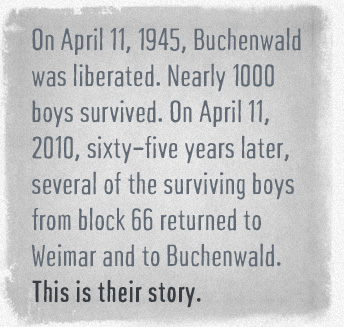After mid-1944, and the Allied landings at Normandy,
World War II appeared to be nearing its bloody end. In the East, the Soviet Army offensive pushed the Nazi war machine back toward Germany’s borders From the West, the US and British armies pushed through France and Belgium toward the Rhine. But even as the war’s likely outcome became clearer, the Nazis continued to fight tenaciously and to carry out their effort to exterminate the Jews of Europe. During 1944, the gas chambers continued operating at Auschwitz-Birkenau until the late fall.
The Buchenwald concentration camp, located near Weimar, in Germany was a central camp in the Nazi slave labor empire, and prisoners were brought to it from camps throughout the Nazi system. Transports arrived at Buchenwald from Auschwitz in spring and summer 1944, and in early 1945, the Nazis forced tens of thousands of Jewish prisoners westward on death marches. Unknown thousands of prisoners died, shot by guards along the roads or frozen in open cattle cars. The survivors were then forced into new camps where chances of survival were limited – prisoners were forced to perform harsh labor, given starvation rations, and subjected to terror and wanton brutality.
Established in 1937, Buchenwald was one of the largest and most well known German concentration camps. Early in its history, there had been Jewish prisoners at Buchenwald, but most had been killed or sent to Auschwitz to die in 1942. Now, in 1944, the Jewish population of Buchenwald rose again as the camp was flooded with some of the remnants of decimated European Jewry. Among these were a large and growing number of teenage boys, many of whom had lost family members in the ghettos and camps of Nazi-occupied Poland, or in the more recent Hungarian deportations to Auschwitz-Birkenau.
The German Communist-led underground at Buchenwald, which administered the camp on a day-to-day basis, recognized this influx of children and youths as requiring a special response. The underground made a conscious decision to do what might be possible to protect the youths. The children were coming in such numbers that leaders in the clandestine conspiracy decided to establish a new children’s block, block 66. The location of the barrack was furthest away from the main gate and Nazi SS gaze, and the area was so horrible and disease ridden, the SS guards seldom went there.
European Jewish children from all over the continent were transferred into the barrack in early 1945. The block was led by Antonin Kalina, a Czech Communist and his deputy, Gustav Schiller, a Polish Jew. The youths in the block did not work and were protected against being sent out of the camp. The block leaders watched over the children and cared for them to the extent possible, seeing in these youths hope for the future. They strove until the last days of the war and beyond to keep them from danger and alive.
On April 11, 1945, Buchenwald was liberated.
Nearly 1000 boys survived.
On April 11, 2010, sixty-five years later, several of the surviving boys from block 66 returned to Weimar and to Buchenwald. This is their story.
DONATE
The International Raoul Wallenberg Foundation ("IRWF") has made Kinderblock 66: Return to Buchenwald one of its key projects, and will be accepting tax-deductible contributions earmarked for its production. We hope that you will consider making a donation to the IRWF. Click here to find out how.
CONTACT
Reach us via email at steve@bigfootnyc.com.









